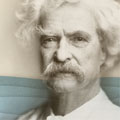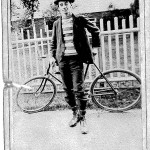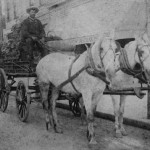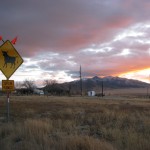Whatever the upbringing of Mark Twain (Sam Clemens) in slave-state Missouri, he was a critic of lynching by adulthood. In “Only a Nigger,”—an August 26, 1869, Buffalo Express column attributed to him—he told of the rape of a white woman in Memphis, for which “an avenging mob” hanged a black man, only to have another confess his guilt.
“Ah, well! Too bad to be sure! A little blunder in the administration of justice by Southern mob-law, but nothing to speak of,” wrote Twain, “Only ‘a nigger’ killed by mistake—that’s all.”
In “The United States of Lyncherdom,” not published until after Twain’s death, he wrote about a Missouri lynching following the murder of a young white woman. Twain tried to understand the “moral cowardice” that led a good man, “afraid of his neighbor’s disapproval,” to join in, even joke about and revel in lynchings.
We too wanted to understand lynchings. So we detoured on our drive from Chicago to Cleveland to visit Marion, Indiana, site of August 7, 1930, lynchings, reportedly the last in the North.
We met with William Munn, Taylor University history professor and Grant County historian, who took us to a small church at Eighteenth and Meridian in Marion. There white workers, some Ku Kluxers, from nearby Superior Body (what irony in that name) plotted to pull three black teenagers out of the Grant County jail and lynch them from trees in front of the county courthouse.
The teenagers had been accused of murdering a white man and raping a white woman. The noose was removed from the neck of one of the three, James Cameron, when a woman, by one account, shouted, “Take this boy back! He had nothing to do with any raping or killing.”
The two 1930 lynchings before thousands of whites, some of whom returned home with body parts and other souvenirs, were captured in an iconic photo. But today nothing in Marion memorializes the lynchings.
All of the trees in front of the courthouse have been cut down, some say to remove from view the lynching trees. Munn said, however, that the courthouse trees are cut down regularly, “so it is a little hard to make that connection.”
But not even a plaque or sign marks the spot. The only reminder at the courthouse of race relations from that era is a monument to local soldiers killed during World War I. Two names have “COL.” next to them, not for colonel, but for colored. Munn said he went to the country commissioners to have that monument changed: “They did say they would do something, but they haven’t.”
As a Marion High School history teacher until last year, Munn encouraged students to undertake ambitious writing and video projects about race. He introduced us to two Marion High School seniors, his son, Evan, and Meredith Kuczora, who had written papers for his U.S. history course that touched on the lynchings.
Kuczora recalled her disbelief at first learning about the local lynchings. She came to understand the town’s silence: “A lot of the families that were involved still live in Marion. It’s a sensitive subject.” In trying to grasp the reasoning of people who participated in lynchings she wound up writing about human ritual sacrifice.
Evan Munn looked at why no marker or monument existed “to show that we publicly observe this tragedy.” He contrasted the response to lynchings in Duluth, Minn., where a memorial was created as an expression of shame and regret, to the effective resistance of the victims’ families in Marion to a memorial.
But Munn said a 2003 Reconciliation Day—organized by black and white Marion ministers—provided a helpful healing for hundreds of citizens. A white minister apologized and asked for forgiveness on behalf of white Christians. A black minister responded: “We forgive those who failed to stand up. From this day forward, we will rise up out of the ashes of disgrace.”
Despite the efforts by many Marion residents to forget the 1930 lynchings, the photo of the lynchings moved Abel Meeropol, a Jew and Communist Party member from New York who wrote poems and songs under the gentile name of Lewis Allan, to compose “Strange Fruit.” The song was published in 1937 and memorably recorded two years later by Billie Holiday.
“She gave a startling, most dramatic, and effective interpretation which could jolt an audience out of its complacency anywhere,” Meeropol said. “This is exactly what I wanted the song to do and why I wrote it.”
Toward the end of her life, addicted to heroin, her body wasted, Holiday hoarsely rasped the song in a way that gave dignity to her suffering and a broader meaning to the song’s words.
Jazz critic Rudi Blesh wrote, “Lynching, to Billie Holiday, meant all the cruelties, all the deaths, from the quick snap of the neck to the slow dying from all kinds of starvation.“
On our way out of town we played Holiday’s “Strange Fruit.” Then, after playing a Holiday jazz standard, the kind you can listen to without thinking about race or racism, we played “Strange Fruit” one last time.
The song reminded me that however much people would like to forget lynchings Holiday’s “Strange Fruit” will forever force us to remember.
Loren Ghiglione


























Pingback: The Fields of Indiana Corn « The Vigilant Lens